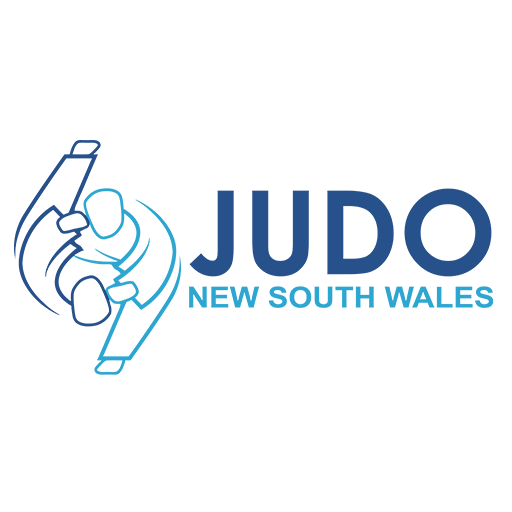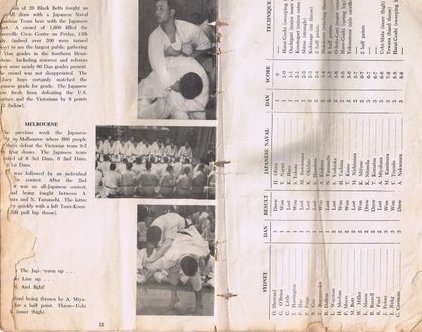BBR History, 1945 to 2010
Compiled by Ric Ryder
History of the Black Belt Register & Judo in New South Wales
The research for information about the history of Judo in New South Wales became a project when we were unable to find any recorded information on the topic. Regrettably, we discovered that valuable documents which had been archived had since been destroyed during the various relocation of the office.
We then contacted several of the remaining pioneers of the early period and listened for many hours about their recollections. These recollections have enabled us to develop a reasonably accurate history of Judo in New South Wales.
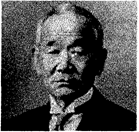
All Judo students should be aware that the origin of Judo was in Japan in 1882 when Professor Kano developed the art of Judo from the ancient art of Ju-Jitsu.
However, Judo in New South Wales did not start to develop until the mid 1940’s to early 1950’s following the end of World War 2. Interested students relied upon the basic teachings of Judo at Landridges Gymnasium or the Kano Judo Ju-Jitsu Club. Other early teachers included Martin Wellington, a visiting Ship’s Officer, Yuzo Usami, a Japanese businessman working in Australia.
Judo gradually gained a stronger following in Australia and began to attract visits from members of the internationally known Budokai club
of England; from goodwill Japanese Navy training fleets and Japanese merchant ships. Newspaper shipping news listings were studied for any arrivals with “Maru” in the ship’s name and club members swooped down to the wharves to collect any Japanese sailor willing to admit that he had some judo experience. They were then whisked away to the dojos in the hope that some expert judo techniques could be attained .
Additionally, there were Judo publications. Most of which were in Japanese writing, but sketches of throws and ‘footprints’ were all helpful for the students.
Judogis and mats were almost unattainable in the 1940’s and 1950 period. Wives and helpers were enlisted to make Judogis; the patterns being a sleeve halfway up the arm and the pants just below the knee. Mats were manufactured or obtained in any possible way. Some mats were soft canvas gym mats which usually developed ridges and lumps causing numerous broken toes for judoka. Other ideas were covered sawdust pits or covered underfelt. Tatami mats of rice straw, covered with non slip vinyl were available but were very expensive and clubs found it more economical to import the packed rice straw and then cover them. Additionally, as most mat surfaces were made of canvas upon which many “sweaty” bodies had toiled and hygiene was not as important as it is today- many infected “mat burns” were the norm.
In the early 1950’s, there were two groups conducting gradings and organising occasional events – The New South Wales Amateur Judo Union and the Black Belt Council.
In 1952 the NSW Olympic Council recognised the Amateur Judo Union (AJU) of New South Wales as the official Judo body. The foundation Committee being Ernie Chambers (the Unions’s first Shodan in NSW) as President; Jim Towers as Secretary and Bob Taylor as Treasurer. The Australian Olympic Council also accepted the National Committee which included Ivan Zvanachos President (Victoria); Ernie Chambers (NSW) Cliff Duncan (Queensland) and Graham Smith (South Australia).
Several Judo Clubs became members of the AJU including Police Boys Clubs; Sydney University; YMCA; YWCA. The first private club to be registered with the NSW AJU was Kodokwai situated at the Belmore PCBC. Marguerite Wilson (Willo Judo Club)) became the first female black belt in NSW. Additionally, the Dan Grades from the NSWAJU had formed their own Black Belt Group titled the “Black Belt Society”. This Society was lead by Andrew Wake and Garry Grennan and ultimately became the Union’s official grading panel.
The Black Belt Council (BBC) comprised of the Black Belts from the Kano Club (Tom Turner; Norm Logan; John Peters; John Ruijg, from Landridges, Geoff and Gray Cooper from Newcastle Judo Club, Tom Lane, Ray Vercoe and several others. The clubs, with whom these Dan Grades were affiliated, also supported the BBC.
Andrew Wake (Sydney University) and John Peters (Kano Judo Club) met to see if the two Black Belt Groups could unite; but it was eventually agreed that forming a new Black Belt Organisation would stand a better chance of success.
Jim Robinson had now arrived in Sydney and after a period of teaching at the Kano Club, had established his own Club at Hurstville.
James Robinson was born in England and became interested in Judo at the age of 12 when he found a Judo book in a secondhand book shop. He joined the British Civil Service and was posted to Shanghai, where 30,000 Japanese resided at the time. This gave him ample opportunity to explore his interest in Judo. He learnt rapidly and in 1927 James moved to Japan and became a member of the old Kodokan in Tokyo. When war broke out with the Japanese James joined the Australian Armed Forces and ironically, the Occupation Forces in Japan. He reached the rank of Captain and was most valuable for his knowledge of the Japanese language and culture. After that service James returned to live in Australia and continued to teach Judo.
James Robinson remained Patron of the BBR until he passed away in 1988 aged 83. Until that time he had been the longest living European member of the Kodokan. Shortly prior to his death he was presented with his Seventh Dan Certificate from the Kodokan at the National Judo Titles in Sydney. James was also presented with a plaque commemorating his contribution to Judo in Australia. To this day, the Black Belt Register (NSW) Inc continues his philosophy of teaching “The spirit of Judo”
John Peters had developed a close association with Jim, and agreed to approach him and encourage him to agree to be Acting Chairman of the new technical organisation. Jim, being a very non political person, took considerable encouraging, but eventually agreed. The year was 1961 and the new organisation was called the “BLACK BELT REGISTER”. The committee comprised of Jim Robinson (President); John Ruijg (Vice President); John Peters (Secretary; Leon Mason (Treasurer); Marguerite Wilson ( Committee); Gray Cooper (Committee). The grading panel of the new BLACK BELT REGISTER. New South Wales (BBRNSW) was Jim Robinson; John Ruijg; John Peters; Ray Vercoe and Andrew Wake.
Now that most of the black belts had united, a meeting was arranged with the New South Wales Amateur Judo Union (NSWAJU) and Jim Robinson, being the most senior dan grade, was appointed Chairman of the BLACK BELT REGISTER. Most of the existing clubs agreed to become affiliated with the one body and the New South Wales Amateur Judo Union was renamed “New South Wales Amateur Judo Association” The Board of management was John Peters (President); John Ruigj (Vice President); Marguerite Wilson (Secretary); Brian Knyvett (Treasurer); Ern Chambers (Committee); Harley Davidson (Committee); Beverley Peters ( Record Secretary). The black Belt Register was appointed as the Technical Board.
This team continued as such to serve Judo for the next 30 years. Jim Robinson, Ern Chambers, John Peters, and Marguerite Wilson were awarded Life Membership of Judo Federation of Australia (New South Wales).
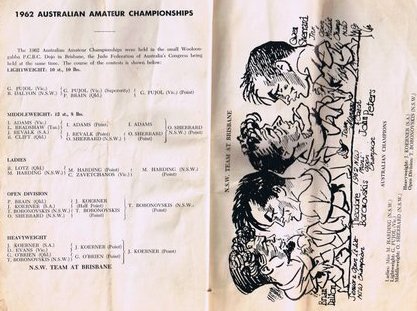
By the late 1950’s and early 1960’s Judo in New South Wales advanced tremendously. Many of our young black belts had become National Champions and Clubs became stronger. With the 1964 Tokyo Olympics approaching and judo now on the program, the BBR appointed John Ruijg, Gary Grennan and John peters as the coaching panel to research and train the NSW squad for the coming National Championships and Olympic Selections. For the first time, a supplementary program of “Circuit Training” devised at Edinburgh University, was added to the squad’s schedule.
New South Wales had just secured Yoshinori Takeuchi 6th Dan, 1962 “All Japan” champion to come to Australia under the Rothmans National Sport Foundation Scheme and he was conducting clinics at the NSWAJA State Dojo which had been temporarily established at Balmain. The fitness, strength and endurance levels of the squad increased with each weekly testing, as did their Judo skills under the training of Yoshinori, affectionally nick named “Nori”.
Gary Grennan was appointed Coach for the team and at the Championships, New South Wales won all divisions. Brian Dalton (Daruma); Ron Ford (Belmore PCBC); Peter Paige (Sydney University) and Ted Boronovskis (Landridges) were selected to represent Australia in the Olympic Team. Brian won his pool, defeated the Korean and lost by close decision to the Russian, Stepanov (Silver Medal); Ted, a New South Wales Police Officer, achieved fame and surprised the rest of the world by winning a Bronze Medal.
By the 1970’s Judo had progressed with many more Clubs and 3000 members. New South Wales had pioneered the development of women’s competition judo and our girls were also winning most of the national titles. Juniors had now joined the seniors in local and national competition. One such junior, Suzanne Williams, joined the Bushido Club when she was 9 years old and went on to gain a remarkable career of achievements; Unquestionably, Suzanne Williams is Australia’s most successful competitive judoka, Sue was twice winner of the British Open Championships – at the time, the unofficial World Championships for women, three times World Silver Medalist, 1988 Olympic Gold Medal (Demonstration Event in Seoul) and winner of the inaugural Fukuoka Cup. Sue was National Champion an amazing 19 time. Sue continued to contribute to Judo after her retirement from competition in various coaching roles. Suzanne Williams has been installed in the New South Wales Sporting Hall of Fame.
In 1986 a Black Belt Register “Member for Life” scheme was introduced. There were Gold, Silver and Bronze membership medallions, each with their own cost and entitlements which came together with a wallet and member card. The criteria being that the membership money was invested in a term account and the BBR used the interest gained for training and development programs. This scheme exists to the present day.
Since inception, the Black Belt Register has annually conducted their technical and grading responsibility to the JFA (NSW) Inc in the form of Kenshusei and Kata Courses; Student Development Program an sponsorship of a division at the New South Wales International Open and the James Robinson prestigious best student award.
Only a few competitors have been mentioned for the highest achievements, however, too numerous to name are judoka who have competed in Olympic Games, World Titles and various international championships. Many have sacrificed good jobs to choose the hard road of living and training overseas to attain excellence in their beloved sport.
BLACK BELT REGISTER ACADEMY – BBRA
In 2004, the Black Belt Register fostered the Black Belt Register Academy (BBRA) which was the brainchild of Ivor Endicott-Davies, Gavin Kelly and Morgan Endicott-Davies, elite competitors who recognised that Judo in New South Wales had progressed to a stage where an Academy of Judo was an essential part of development. Their mission is simple, to provide elite training, conduct highly specialised courses and coordinate an International Student Development Program with focus only to what happens inside the red mat area.
Since starting the Academy has invited numerous national and international coaches who have conducted regular training nights and special courses for elite judo students. Together with the BBR they have sponsored elite competitors to train at the Kodokan and also a Student Development Program to send squads of students for international competition and training.
*****************
EARLY EVENTS – NEW SOUTH WALES Vs VICTORIA WRESTLING STADIUM LEICHHARDT SYDNEY
In 1958 the Black Belt Council selected a team to compete against a Victorian team selected by the Australian Judo Association an organisation lead by Jack Cox, Frank Dando, Bob Todd and Kevin Todd. The NSW team comprised John Peters (Kano Club); (capt.), John Ruijg (Landridges(; (a Dutch 2nd dan recently arrived in Sydney), Geoff and Gray Cooper (Newcastle Club) and Jim Ware (Kano Club). Frank Dando had returned from several years training in Japan and was considered unbeatable. Victoria was the firm favourites. The format was to match team members alternatively.
After three contests NSW were down 2-1, leaving Bod Todd and Frank Dando on the Victorian team and John Ruijg and John Peters on the NSW team. In a tactical switch, when Bob Todd came onto the mat, John Peters stood up to fight him, leaving the newly arrived John Ruijg, the unknown quantity to fight Dando. Peters defeated Todd to square the match 2-2 and Ruijg caused the biggest upset by downing Dando to give NSW the match 3-2
In a return match the following year, with unification within the State underway, team selections took place over a series of weekends at Landridges Club. Entrants included John Ruijg, John Peters, Geoff and Gray Cooper, Andrew Wake, Garry Grennan, Harry Meehan, Cedric Little, Jack Vander Mark, Joe Zalgevicious, Peter Paige and several other dan grades, making a total entry of sixteen (16). The format was round robin, so everyone has fifteen(15) contests. The team selected was Ruijg, Peters,Wake,Grennan and Zalgevicious. The match was held at Leichhardt Boxing Stadium (the building was demolished some years later) and a NSW All-Grades Championships was held at the same time. The finals of the Championships and the return team match were staged on a Saturday night and the stadium was filled to overflowing. The Victorian team unearthed their own star performer, a Frenchman – Guy Pujol and they went on to win the match.
This was the largest audience, to this time, to ever view a Judo Event in Australia.
NEW SOUTH WALES vs JAPANESE NAVY
TEAMHURSTVILLE CIVIC CENTRE
In 1961 the Japanese Naval Training Squadron (actually The Japanese Navy) came to Sydney. They had a crack judo team that had beaten the US marines and also the Victorian team. A match was arranged at the Hurstville Civic Centre that attracted the Sydney press and the ABC News. All live news coverage had to be recorded to film by an outside broadcasting unit before going to the TV station news.
The TV coverage of the Squadron’s visit resulted in a sell-out crowd, with many turned away at the doors. Sydney managed to field 20 black belts and in an exciting match, the home team came from 2 contests down, with 3 to play to win the next 2 and draw the last – finishing with a draw overall. (see old copy of judo magazine for full results)
NSW STATE TITLES – SYDNEY BOXING STADIUM RUSHCUTTERS BAY
The old Sydney Stadium at Rushcutters Bay was another unusual venue used to stage a major judo event. In 1963 NSW was fortunate in securing from the Kodokan, Yoshinori Takeuchi 6th Dan, 1962 All Japan Champion, on a 6 months contract. In conjuction with the finals of the State Titles, Nori (as he was fondly called), was the star attraction competing against a line-up of our eager young black belts. The stadium has long since gone, but the memory of that night still remains with those fortunate to be there. Yoshinori went on to become an IJF referee, a member of the IJF Referees’ Commission, and eventually, President of the Asian Judo Union.
BBR PICTURE GALLERY
Some pictures may be expanded by clicking on them. If you can provide more pictures or names and information regarding the below pictures (who’s who), please send to the [email protected]
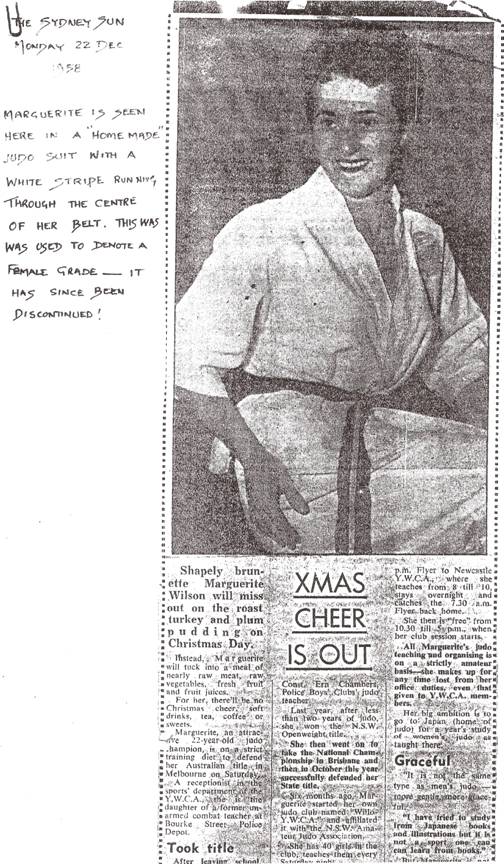 |
Marguerite Wilson: First female Black Belt in NSW, former National Champ . On NSW Board for 30 years as secretary. Photo taken from Newspaper article 1958. |
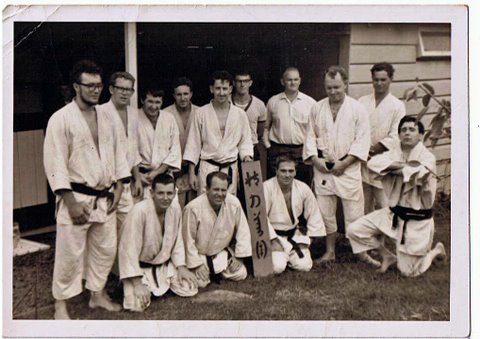 |
Opening of the Daruma Dojo, Frenchs Forest, 1960
Backrow: Greg O’Brien (Qld), Peter Paige, Ferdi Moers, Ron Cox, John Peters, Brian Knyvett, Cliff Crates, Jim Ware, Owen Sherrard Front row: Ron Ford, Tommy Lane, Mike Butt, Dennis Holland |
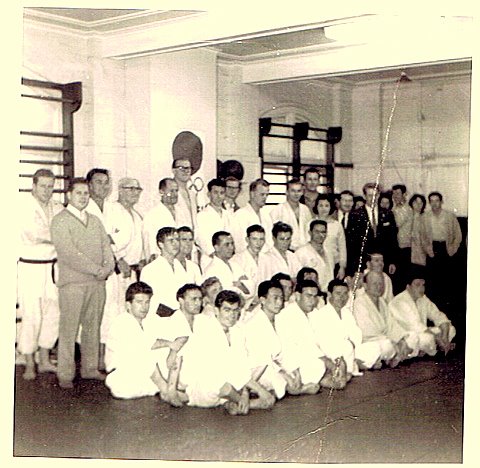 |
An early training camp at Landridges, 1958
Prior to Nationals in Melbourne Photo includes: Warren Miller, Harry Meehan, Jim Selby, Jim Robinson, Ray Vercoe, Andrew Wake, John Peters, Janck Vander Mark, John Ruijg, Gary Grennam, Leon Mason, Marguerite Wilson, Ferdi Moers, Franz Limbach. Remainder were junior grades participating. |
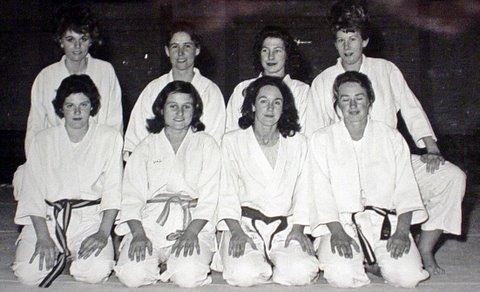 |
Takeuchi sensei’s Senior Women’s Class, Balmain, 1963
Back Row: Cindy ; Eva Samenek; Judy Bell; Yvonne Morrow Front Row: Margaret, Patty Clifton, Helen ? |
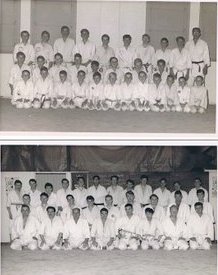 |
Top Photo: Takeuchi sensei’s Junior Class, 1963
Top photo includes Terry Young and Warren Richards, both later to be National Champions. Bottom Photo: Takeuchi sensei’s Kyu Grades Class, 1963 Bottom photo includes John Tisdale (Next to Takeuchi sensei), andlater to be National Champion and President AJA (NSW) |
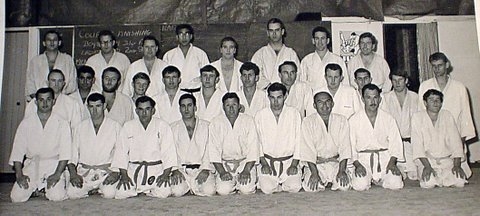 |
Takeuchi sensei’s Senior Class, 1963
Back row: Garry Grennan, Peter Paige, Harry Meehan, Yoshinori Takeuchi, Mike Butt, Ted Boronovskis, John Peters, Col Elphick Middle row: Leo Maloney, ? , Tony Kelly, David Givney, ? , Doug Haack, Ray Etteridge, Ed Trower, ? , ? , David Nash, John Buckley Front row: ? , ? , ? , ? , Sid Littler, ? , Jack Halber, Ron Ward, Peter Nash |
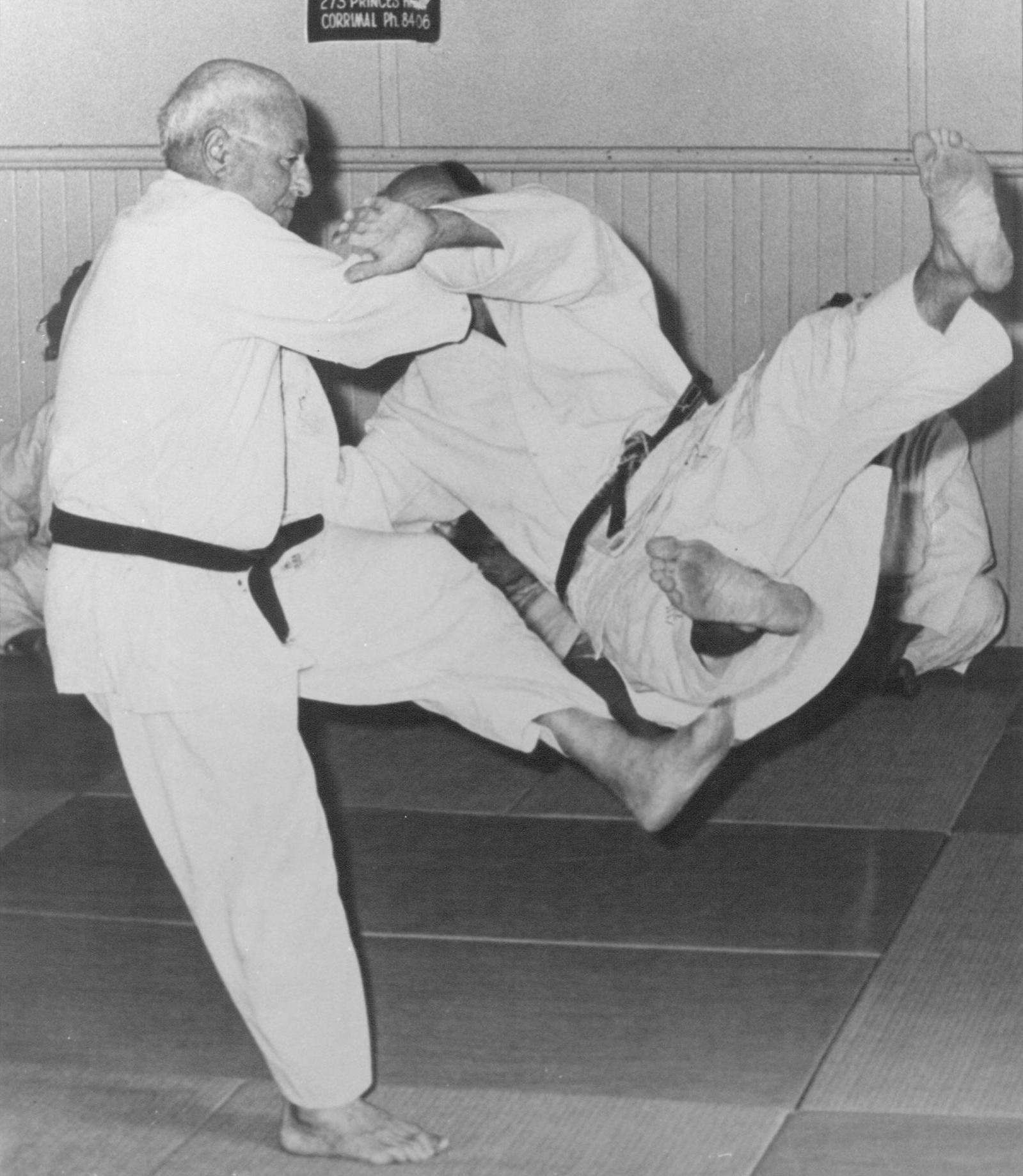 |
Two of the original BBR committee members, James Robinson, 6th Dan, Sensei, and Ray Vercoe, 5th Dan demonstrating throws to students at the Hurstville “Kodokan” Dojo. Jim’s students affectionally named it the Kodokan in respect of his continuous teachings of ‘The Spirit of Judo’. |
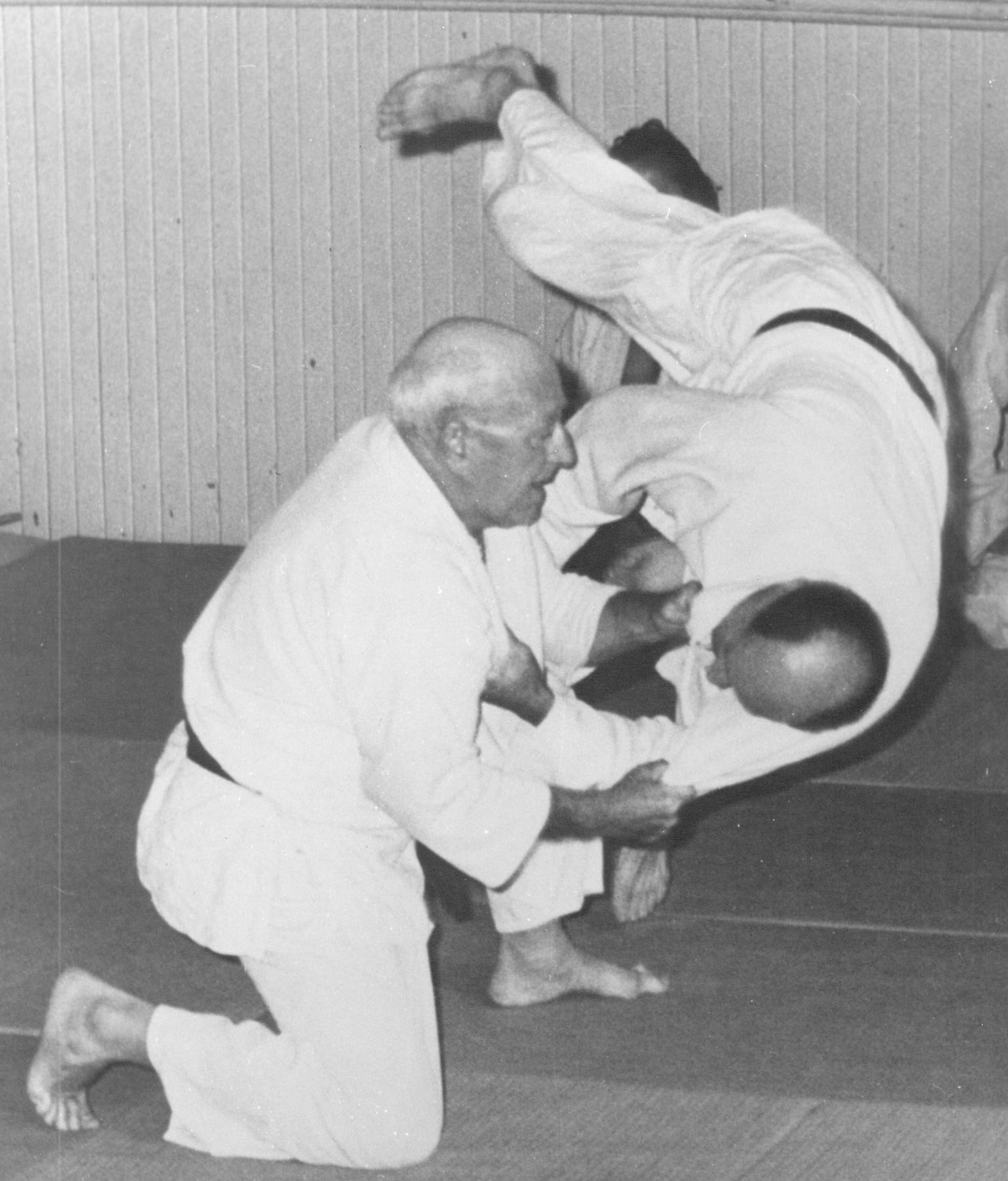 |
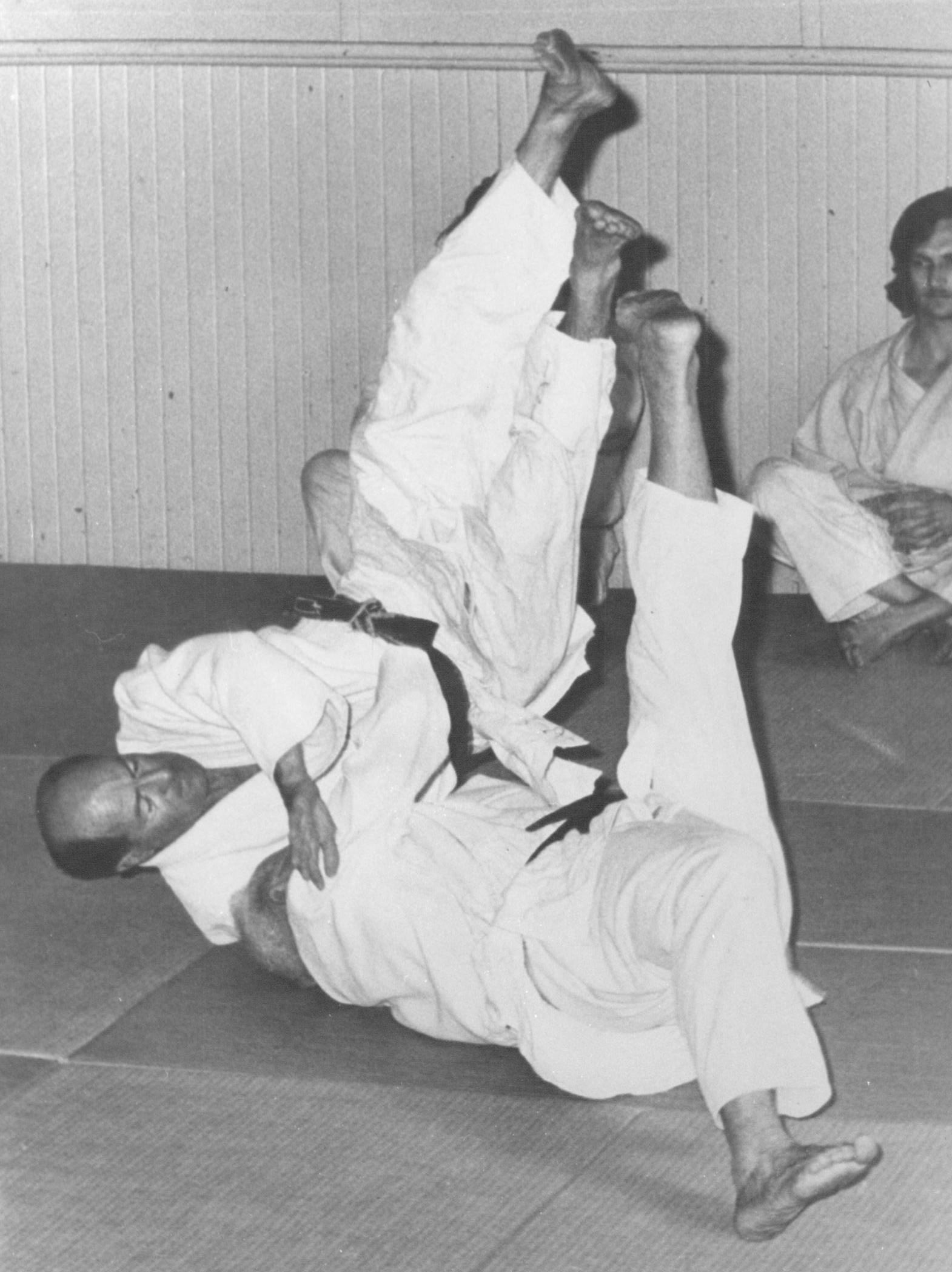 |
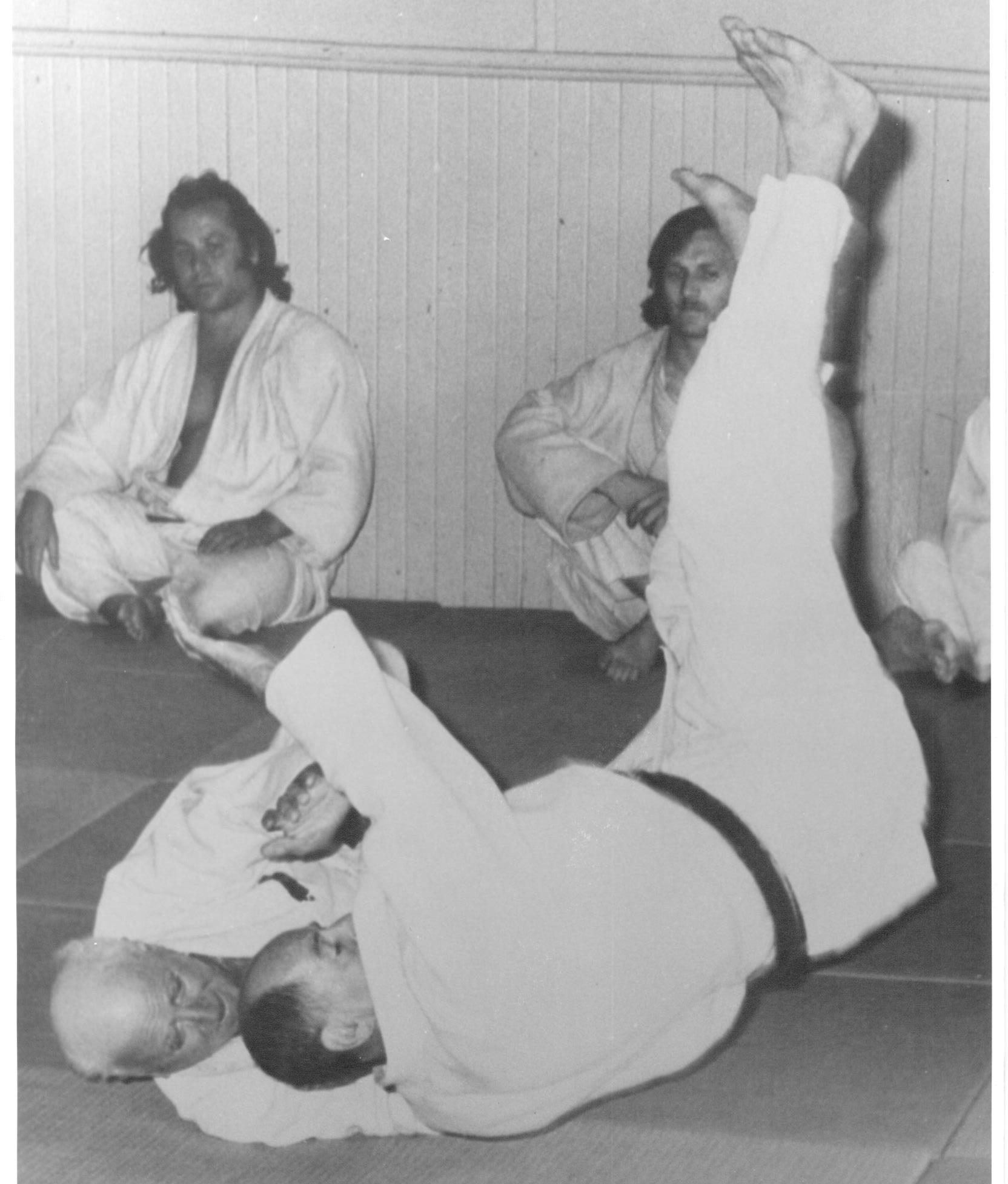 |
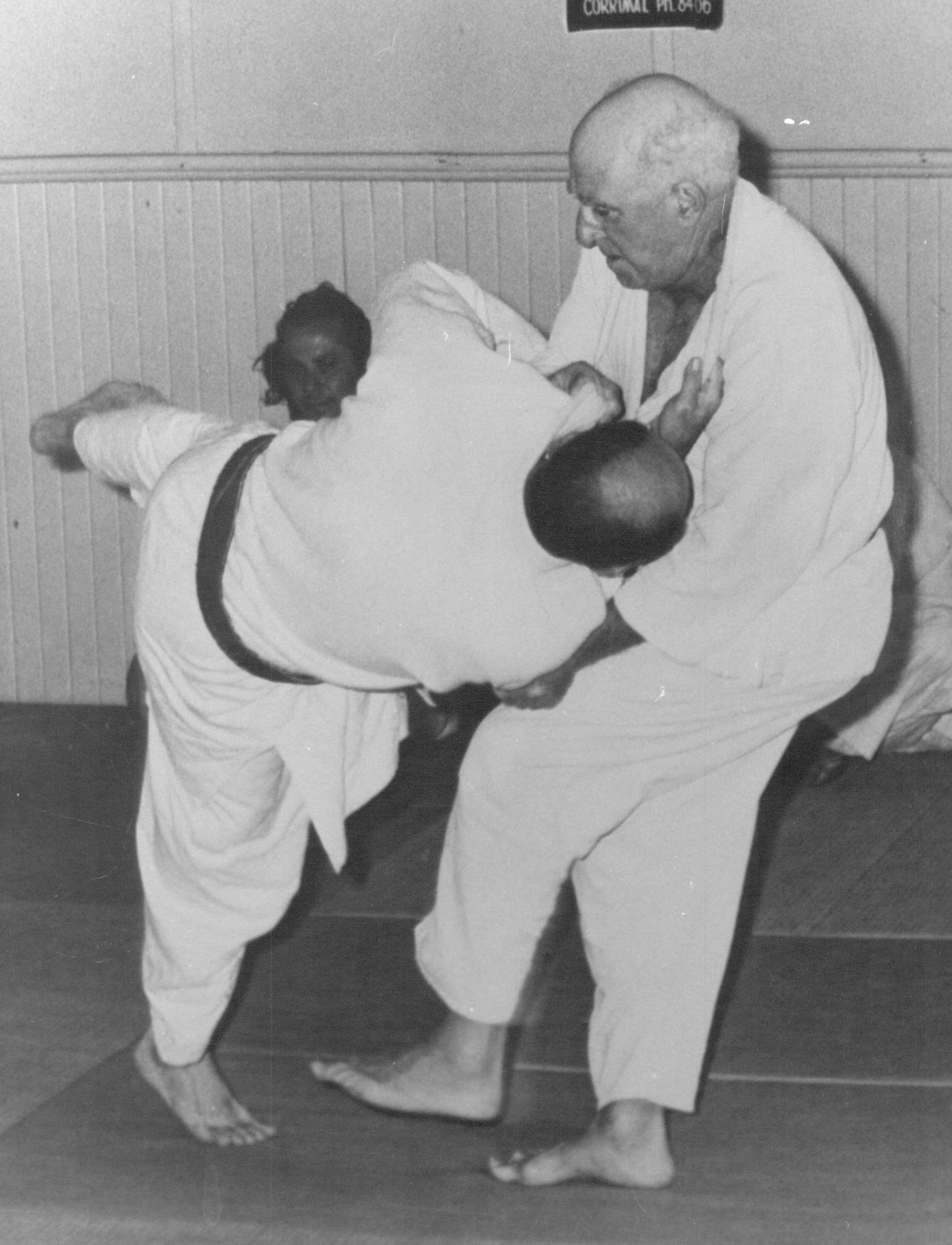 |
| Contact BBR by Email: [email protected] | 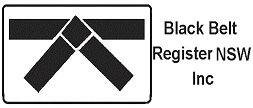 |
